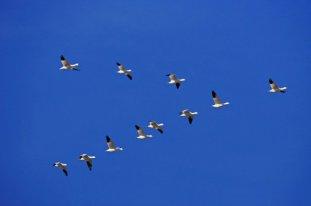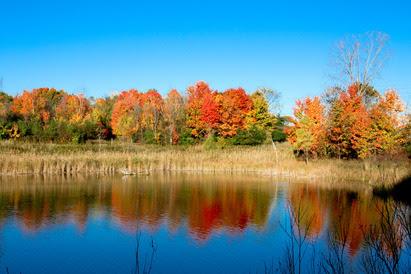Tuesday, Oct 9, 2018
By Abby Pointer, MNA Intern
As our summer slowly shifts into Michigan’s favorite season, the humidity will disappear into a brisk breeze and leaves will turn happy orange and red. You might partake in festive, nature oriented activities such as apple picking, birding, or fall color walks. Our reason for doing this is to enjoy some time with friends and family, but have you thought about the reason why nature acts as it does in the fall?

Since Autumn is a transitional season, often the plants and animals we see are in a transition period as they prepare for a long winter. For instance, birds are migrating back from their summer homes to somewhere less chilly for the winter. To many avid birders’ delights, we are lucky in Michigan to be able to see rare species such as warblers, vireos, and thrushes migrating. If you visit Whitefish Point, it is an excellent place to spot the migrating loons and, if you look towards the skies, you might also spot the soaring wingspans of sharp shinned hawks, bald eagles, and ospreys.
While the birds fly south, mammals take advantage of fall fruiting trees and plants. Species such as squirrels, chipmunks, and even bears might be more active as they prepare themselves for winter by gathering food and preparing nests or dens. Many types of berries and nuts ripen for consumption in the fall, and as the temperature cools, fungi also begin to sprout. The production of berries, nuts, and seeds this time of year cleverly coincides with the time that birds are stopping to snack during migration and when small mammals bury nuts for sparser months. These fruits and nuts are the structures that enable the dispersal of seeds, so these animals in transition are essential in the process of creating new plant life for some tree and shrub species such as red chokeberry, blackhaw viburnum, and common ninebark. Acorns from oak trees and hickory nuts serve the same purpose and are spread by small mammals in a process sometimes known as “scatter hoarding”.

While animals collect the nuts from trees for winter hibernation, the trees themselves have a very charismatic process that prepares them for their own kind of hibernation. During the winter months, deciduous trees go into a period of dormancy where they survive off the energy they stored during the sunny summer months, and they drop their leaves that contain chloroplasts (structures that turn light from the sun into plant food) to conserve energy. Leaves of trees can sense a shortening period of daylight, and eventually stop producing the chemical chlorophyll that make leaves green, and then we can see bright colored pigments such as orange and red that were previously masked by green all summer. We see the best fall colors when there is a wet growing season followed by a cool, frostless fall. Visit an MNA sanctuary to see this trees in action. Enjoy the colors!
